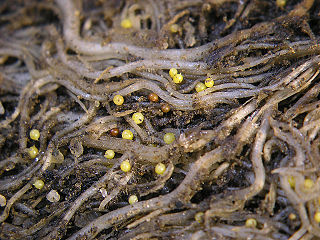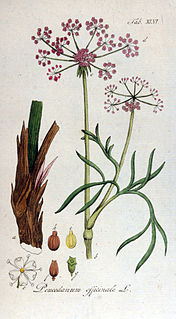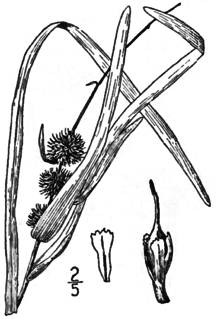
IQ are a British neo-progressive rock band founded by Mike Holmes and Martin Orford in 1981 following the dissolution of their original band The Lens. Although the band have never enjoyed major commercial success and had several line up changes, IQ have built up a loyal following over the years and are still active as of 2019, currently with the original recording lineup. In 2011, IQ performed a series of concerts in the UK and Europe celebrating their 30th anniversary.

The Typhaceae are a family of flowering plants, sometimes called the cattail family. The botanical name for the family has been recognized by most taxonomists.

James Michael Nicholl is a former Northern Ireland international footballer who played for several clubs, including Manchester United and Rangers. He was mainly a right-back but could also play in other defensive roles. Nicholl won a total of 73 international caps for Northern Ireland, scoring one goal.

Sparganium (bur-reed) is a genus of flowering plants, described as a genus by Linnaeus in 1753. It is widespread in wet areas in temperate regions of both the Northern and Southern Hemispheres. The plants are perennial marsh plants that can grow to 3.5 m, with epicene flowers.

The River Rom, also known as the River Beam below its confluence with the Ravensbourne, is a tributary of the River Thames in England that flows through east London suburbs surrounding the metropolitan centre of Romford, forming the boundary between the London boroughs of Barking and Dagenham and Havering. The Rom is culverted for a brief midsection as it passes through the centre of Romford.

Cypripedium acaule is a member of the orchid genus Cypripedium. Members of this genus are commonly referred to as lady's slipper orchids. First described in 1789 by Scottish botanist William Aiton, C. acaule is commonly referred to as the pink lady's slipper, stemless lady's-slipper, or moccasin flower. The pink lady's slipper is the provincial flower of Prince Edward Island, Canada and the state wildflower of New Hampshire, United States. Its close relative, Cypripedium reginae, is the state flower of Minnesota.

Potato root nematodes or potato cyst nematodes (PCN) are 1-mm long roundworms belonging to the genus Globodera, which comprises around 12 species. They live on the roots of plants of the family Solanaceae, such as potatoes and tomatoes. PCN cause growth retardation and, at very high population densities, damage to the roots and early senescence of plants. The nematode is not indigenous to Europe but originates from the Andes. Fields are free from PCN until an introduction occurs, after which the typical patches, or hotspots, occur on the farmland. These patches can become full field infestations when unchecked. Yield reductions can average up to 60% at high population densities.

Peucedanum is a genus of flowering plant in the carrot family, Apiaceae.

Sparganium eurycarpum is a species of bur-reed known by the common names broadfruit bur-reed and giant bur-reed. It is native to wetlands in Eurasia and North America. It is a clonal perennial, spreading by below-ground rhizomes. The common name, bur-reed, arises from the distinctive round clusters of fruits that take the form of a mace. It can be distinguished from all other species of bur-reed by the presence of two stigmas.
Branched bur-reed is a common name for several plants in the genus Sparganium and may refer to:

Cypripedium reginae, known as the showy lady's slipper, pink-and-white lady's-slipper, or the queen's lady's-slipper, is a rare lady's-slipper orchid native to northern North America. Although never common, this plant has vanished from much of its historical range due to habitat loss. It is the state flower of Minnesota.

Cirsium acaule or acaulon has the English name dwarf thistle or stemless thistle. It is widespread across much of Europe. It is often found on short, calcerous grasslands.

Sparganium emersum is a species of flowering plant in the cat-tail family known by the common names European bur-reed and unbranched bur-reed. It has a circumboreal distribution, occurring throughout the northern latitudes of Eurasia and North America. It is an aquatic plant, growing in shallow water bodies such as ponds and streams. It can become abundant at times. It is a perennial herb producing a floating stem up to 2 meters long. The leaves may be limp and floating or stiff and erect, emerging above the water surface. The leaves are flat and straplike, sometimes with a triangular, keeled base that can help distinguish it from the similar Sparganium angustifolium. It is monoecious, individual plants bearing both male and female inflorescences. These are spherical, the male inflorescence a ball of stamens and the female inflorescence a ball of developing fruits growing beneath the male spheres.
The Don and Gee Nicholl Fellowships in Screenwriting is a fellowship program founded in 1986 to aid screenwriters. It is administered by the Academy of Motion Picture Arts and Sciences.
Orthotelia is a genus of moths in the subfamily Orthoteliinae.Orthotelia sparganella, a moth of the family Glyphipterigidae, is its only species.

Twin Lakes Bog State Natural Area is a Wisconsin Department of Natural Resources-designated State Natural Area featuring an intact tamarack swamp lying in a depression between two kettle lakes. The understory of the swamp has an open aspect to it, and is dominated by the ericaceous shrubs Labrador tea, bog laurel, and leatherleaf. Other common plant species found here include: wooly-fruit Sedge, twinflower, cinnamon fern, sundews and, and the notably abundant pink ladyslipper. Three small bog lakes, surrounded by quaking bog mats, are found in the interior of the swamp. Uplands surrounding the swamp are forested with second-growth hardwoods dominated by sugar maple and red oak. In 1989, the US Forest Service designated Twin Lakes Bog as a Research Natural Area.

Sparganium americanum, American bur-reed, is a perennial plant found in the United States of America and Canada. Though this species resembles a grass, it is a type of bur-reed. This species is important for conservation purposes because it has the ability to remove nitrogen and phosphorus runoff from water, like many other wetland species. By doing this it protects waterways from excess nitrogen which can cause eutrophication. This increased nitrogen is especially a problem during the farmers’ growing season. During this same time frame the S. americanum is growing and taking up nitrogen.
Anthurium acaule is a herbaceous plant native to the Lesser Antilles. The plant has a complicated taxonomic history, and the name Anthurium acaule has been applied to several other plants.
Ute Müller-Doblies is a German botanist with an interest in the systematics of Amaryllidaceae. She is currently at the Herbarium of the Technische Universität Berlin in collaboration with Dietrich Müller-Doblies (D.Müll.-Doblies.).

Tingewick Meadows is an 11.1 hectare biological Site of Special Scientific Interest south of Tingewick in Buckinghamshire.














